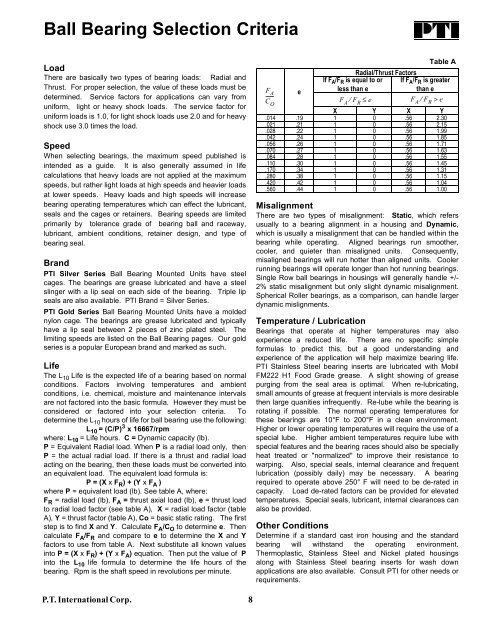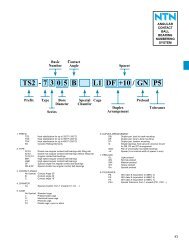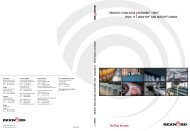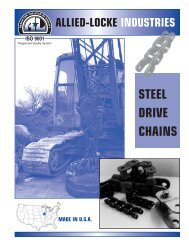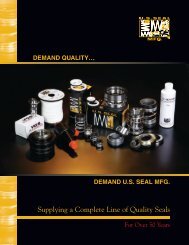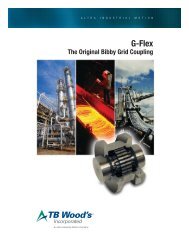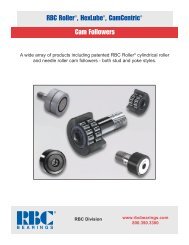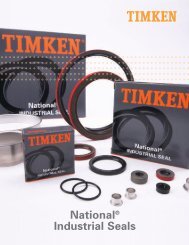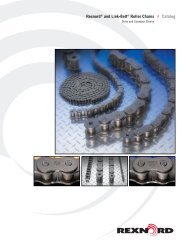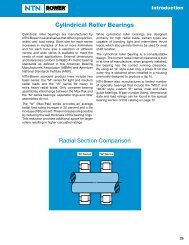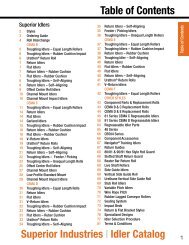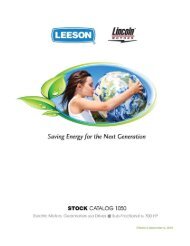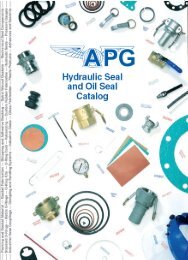PTI Bearing Catalog - Norfolkbearings.com
PTI Bearing Catalog - Norfolkbearings.com
PTI Bearing Catalog - Norfolkbearings.com
Create successful ePaper yourself
Turn your PDF publications into a flip-book with our unique Google optimized e-Paper software.
Ball <strong>Bearing</strong> Selection Criteria<br />
Load<br />
There are basically two types of bearing loads: Radial and<br />
Thrust. For proper selection, the value of these loads must be<br />
determined. Service factors for applications can vary from<br />
uniform, light or heavy shock loads. The service factor for<br />
uniform loads is 1.0, for light shock loads use 2.0 and for heavy<br />
shock use 3.0 times the load.<br />
Speed<br />
When selecting bearings, the maximum speed published is<br />
intended as a guide. It is also generally assumed in life<br />
calculations that heavy loads are not applied at the maximum<br />
speeds, but rather light loads at high speeds and heavier loads<br />
at lower speeds. Heavy loads and high speeds will increase<br />
bearing operating temperatures which can effect the lubricant,<br />
seals and the cages or retainers. <strong>Bearing</strong> speeds are limited<br />
primarily by tolerance grade of bearing ball and raceway,<br />
lubricant, ambient conditions, retainer design, and type of<br />
bearing seal.<br />
Brand<br />
<strong>PTI</strong> Silver Series Ball <strong>Bearing</strong> Mounted Units have steel<br />
cages. The bearings are grease lubricated and have a steel<br />
slinger with a lip seal on each side of the bearing. Triple lip<br />
seals are also available. <strong>PTI</strong> Brand = Silver Series.<br />
<strong>PTI</strong> Gold Series Ball <strong>Bearing</strong> Mounted Units have a molded<br />
nylon cage. The bearings are grease lubricated and typically<br />
have a lip seal between 2 pieces of zinc plated steel. The<br />
limiting speeds are listed on the Ball <strong>Bearing</strong> pages. Our gold<br />
series is a popular European brand and marked as such.<br />
Life<br />
The L 10 Life is the expected life of a bearing based on normal<br />
conditions. Factors involving temperatures and ambient<br />
conditions, i.e. chemical, moisture and maintenance intervals<br />
are not factored into the basic formula. However they must be<br />
considered or factored into your selection criteria. To<br />
determine the L 10 hours of life for ball bearing use the following:<br />
L 10 = (C/P) 3 x 16667/rpm<br />
where: L 10 = Life hours. C = Dynamic capacity (lb).<br />
P = Equivalent Radial load. When P is a radial load only, then<br />
P = the actual radial load. If there is a thrust and radial load<br />
acting on the bearing, then these loads must be converted into<br />
an equivalent load. The equivalent load formula is:<br />
P = (X x F R ) + (Y x F A )<br />
where P = equivalent load (lb). See table A, where:<br />
F R = radial load (lb), F A = thrust axial load (lb), e = thrust load<br />
to radial load factor (see table A), X = radial load factor (table<br />
A), Y = thrust factor (table A), Co = basic static rating. The first<br />
step is to find X and Y. Calculate F A /C O to determine e. Then<br />
calculate F A /F R and <strong>com</strong>pare to e to determine the X and Y<br />
factors to use from table A. Next substitute all known values<br />
into P = (X x F R ) + (Y x F A ) equation. Then put the value of P<br />
into the L 10 life formula to determine the life hours of the<br />
bearing. Rpm is the shaft speed in revolutions per minute.<br />
F<br />
------ A<br />
e<br />
If F A /F R is equal to or<br />
less than e<br />
Radial/Thrust Factors<br />
Table A<br />
If F A /F R is greater<br />
than e<br />
⁄ > e<br />
C O<br />
F A ⁄ F R ≤ e<br />
F A F R<br />
X Y X Y<br />
.014 .19 1 0 .56 2.30<br />
.021 .21 1 0 .56 2.15<br />
.028 .22 1 0 .56 1.99<br />
.042 .24 1 0 .56 1.85<br />
.056 .26 1 0 .56 1.71<br />
.070 .27 1 0 .56 1.63<br />
.084 .28 1 0 .56 1.55<br />
.110 .30 1 0 .56 1.45<br />
.170 .34 1 0 .56 1.31<br />
.280 .38 1 0 .56 1.15<br />
.420 .42 1 0 .56 1.04<br />
.560 .44 1 0 .56 1.00<br />
Misalignment<br />
There are two types of misalignment: Static, which refers<br />
usually to a bearing alignment in a housing and Dynamic,<br />
which is usually a misalignment that can be handled within the<br />
bearing while operating. Aligned bearings run smoother,<br />
cooler, and quieter than misaligned units. Consequently,<br />
misaligned bearings will run hotter than aligned units. Cooler<br />
running bearings will operate longer than hot running bearings.<br />
Single Row ball bearings in housings will generally handle +/-<br />
2% static misalignment but only slight dynamic misalignment.<br />
Spherical Roller bearings, as a <strong>com</strong>parison, can handle larger<br />
dynamic mislignments.<br />
Temperature / Lubrication<br />
<strong>Bearing</strong>s that operate at higher temperatures may also<br />
experience a reduced life. There are no specific simple<br />
formulas to predict this, but a good understanding and<br />
experience of the application will help maximize bearing life.<br />
<strong>PTI</strong> Stainless Steel bearing inserts are lubricated with Mobil<br />
FM222 H1 Food Grade grease. A slight showing of grease<br />
purging from the seal area is optimal. When re-lubricating,<br />
small amounts of grease at frequent intervials is more desirable<br />
then large quanities infrequently. Re-lube while the bearing is<br />
rotating if possible. The normal operating temperatures for<br />
these bearings are 10°F to 200°F in a clean environment.<br />
Higher or lower operating temperatures will require the use of a<br />
special lube. Higher ambient temperatures require lube with<br />
special features and the bearing races should also be specially<br />
heat treated or "normalized" to improve their resistance to<br />
warping. Also, special seals, internal clearance and frequent<br />
lubrication (possibly daily) may be necessary. A bearing<br />
required to operate above 250° F will need to be de-rated in<br />
capacity. Load de-rated factors can be provided for elevated<br />
temperatures. Special seals, lubricant, internal clearances can<br />
also be provided.<br />
Other Conditions<br />
Determine if a standard cast iron housing and the standard<br />
bearing will withstand the operating environment.<br />
Thermoplastic, Stainless Steel and Nickel plated housings<br />
along with Stainless Steel bearing inserts for wash down<br />
applications are also available. Consult <strong>PTI</strong> for other needs or<br />
requirements.<br />
P.T. International Corp.<br />
8


